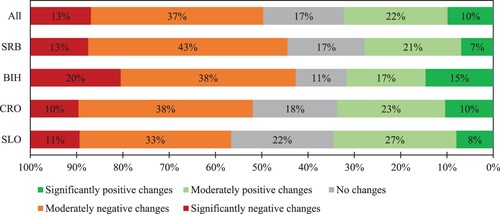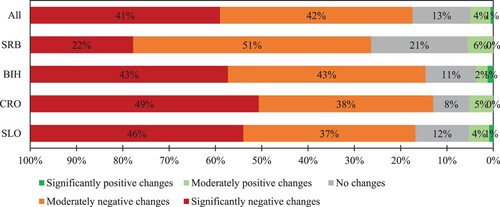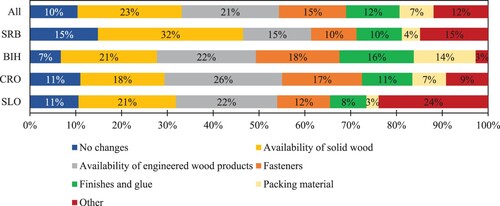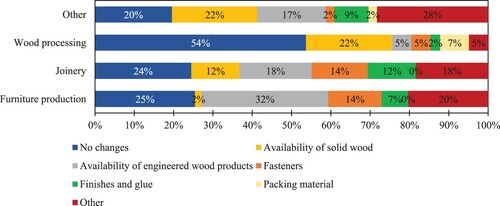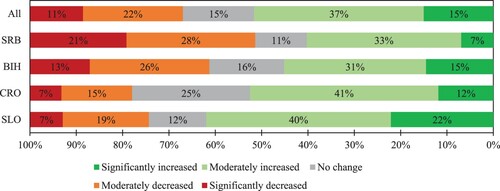ABSTRACT
The COVID-19 pandemic has significantly impacted the forest-products industry locally and globally, including the availability of raw materials, supply chain, production, and product sales. Therefore, it was essential to study the effect of COVID-19 in Central and Southeast European countries, including Slovenia, Croatia, Serbia, and Bosnia and Herzegovina, where the forest-products industry plays a vital global role. An international group of wood scientists developed and implemented the web-based questionnaire that consisted of four parts: demographic questions, production changes, COVID data gathering, governmental response to COVID-19, and lessons learned. Participants were mainly from furniture production, joinery, and wood processing. Results indicate that more than 80% of respondents reported negative changes. The COVID-19 pandemic has seriously affected the supply chain, and the most significant changes were in the availability of solid wood (23%) and engineered wood products (21%). Among the most critical issues were increased prices of all materials, increased transportation costs, extended delivery times, limited quantities for all materials, and total disruption of supply chains.
KEYWORDS:
1. Introduction
The pandemic caused by a new coronavirus in 2019 (COVID-19) has disrupted societies and global economies. The viruses are primarily spread through the air by coughing, sneezing, and close personal contact (NIAID-National Institute of Allergy and Infection Diseases Citation2020). To reduce virus transmission, some activities took place globally: self-isolation, travel restrictions, and the shutting down of some parts of economies (Stanturf and Mansuy Citation2021).
The COVID-19 outbreak has also directly impacted the forest products market and indirectly the demand for endproducts (Muhammad Citation2021).
The global demand for wood-based products is directly linked to the global market for finished wood products (e.g. furniture and flooring). Therefore, manufacturers worldwide have a “derived” demand for raw materials such as logs and lumber based on the need for end- products.
The forest-products industry is heavily integrated with the larger economy through timber products, housing, manufacturing, and a variety of consumer goods. In general, the pandemic affected the demand for many consumer goods and the manufacturing of wood-based products (Pelkki and Sherman Citation2020).
During the pandemic, home remodeling took place everywhere because of stay-at-home orders, and the demand for goods, among them wood products, raised significantly. In addition, sanitary paper markets were suddenly robust. Other changes took place and affected the operation of almost all companies and their function in the global trade. As a result, there was a need to reevaluate the function, infrastructure, and future development (Hightower Citation2020, Barbu and Tudor Citation2021).
In the context of the deep integration and globalization of the world economy, COVID-19 has brought severe challenges to global industry supply chains (Liu et al. Citation2020). On the bright side, it is also believed that the pandemic provided opportunities for a shift in global development toward greater sustainability and a greener, more inclusive economy (Stanturf and Mansuy Citation2021).
To understand the problem on a global scale, a literature review related to the COVID-19 pandemic and the forest products industry was conducted. Størdal et al. (Citation2021) examined the financial performance of the forest products industry in the initial phase of the COVID-19 pandemic, employing global data for publicly trading companies in the industry. Pirc Barčić et al. (Citation2021) tried to understand the impact of the COVID-19 pandemic on consumers’ preferences for wood furniture. They provided some suggestions for policies to the related governmental agencies and wood furniture manufacturers to reduce the negative impact of a pandemic on the wood furniture industry. Liu et al. (Citation2020) examined global COVID-19 challenges and perspectives for the pulp and paper industry worldwide. ChenYang (Citation2021) found that the COVID-19 pandemic has reduced consumers’ preferences for wood furniture. Still, the significant finding was that decline in this preference was less important for extra-large furniture manufacturers. Saxena et al. (Citation2021) suggested some fundamental principles for integrating forest-based livelihoods into “green recovery,” founded on principles that articulate forests as complex and integrated social-ecological systems, prioritize equity, and build on past learnings of community-based forest management. Next, the Dynamic Impacts of the COVID-19 Pandemic on Log Prices in China were analyzed by Tao et al. (Citation2021). Finally, Shen et al. (Citation2020) studied the impact of the COVID-19 pandemic on Firm Performance. Investigating the Croatian and Slovenian SMEs wood industry by Jelačić et al. (Citation2021) showed that, to survive the COVID-19 global pandemic crisis, entrepreneurs and managers in SMEs turned their way of thinking and their managerial skills into inner strength. More precisely, managers focused on production programs and the quality of their products since the lockdown and pandemic made it much harder to be innovative on the market or to put efforts into finding new markets. Similar findings were noted by Ratnasingam et al. (Citation2020). They said that during the COVID-19 crisis, the SMEs in the Malaysian furniture industry sector had been intensely affected in terms of financial management and supply chain disruptions (e.g. the ability to pay wages, utilities, and loan services).
The research objective of this study is to identify changes in production in countries of SCE since the start of the COVID-19 pandemic. The study addressed changes in the supply chain and any possible positive impact during the COVID-19 pandemic, perspectives, and policy recommendations in the light of the demand for innovative climate-neutral circular solutions, environment-friendly products, and production, waste prevention, product lifetime extension, and significant improvement of the lifecycle performance of buildings and their components, including digitalization, BIM, innovations, and related innovative practices.
The forest-products industry in Central and Southeast Europe is an essential contributor to the global wood products economy and its consumers. Group of wood products scientists believe that monitoring changes during the COVID-19 pandemic in this geographic area are critical for navigating future development and positive change, which was the primary goal of this study.
1.1. Forest-based industry in studied countries
The wood sector has a long tradition in Slovenia, Croatia, Serbia, and Bosnia and Herzegovina (BiH), and it has always been an important segment of each country's economy. As a result, the economic development of the forest sector of all Central and Southeast European countries (CSE) is significantly based on the utilization of domestic forest resources, sawmilling, and the furniture industry (FAO, UECE Citation2021).
The forest cover in the selected CSE is 8.1 million ha, with annual round timber removals of about 21.6 million m3 (FAO-WISDOM (Woodfuel Integrated Supply /Demand Overview Mapping) Citation2020, FAOSTAT Citation2020, FAO Citation2020, FAO Citation2020). The forest products sector of CSE employs about 122 thousand people and creates an annual gross value added of 2.7 billion EUR (INSTAT-Institute for Statistics of Albania Citation2020, Agency for Statistics of Bosnia and Herzegovina (BHAS) Citation2020a). Additionally, wooden furniture accounts for about 1.1 billion EUR of the value of all exported forest products from the CSE.
All countries of the CSE consider the forest sector as strategic and very important to their economies. However, there is a significant potential for expanding their production and export. For example, the share of the wood-based sector gross value added to the GDP of each country varies from 1% in Croatia to 4% in BiH, respectively. The detailed data for each studied country are presented in .
Table 1. Government statistics 2020 and 2021 for the forest products industry in Slovenia, Croatia, Serbia, and BiH.
Unfortunately, these countries have experienced many economic and social changes in the last three decades that directly or indirectly influenced the wood-products sector. Nevertheless, these markets are attracting domestic, as well as foreign investors. In recent years, particularly in Slovenia, a national effort has increased the wood used in residential construction. The primary intention is to lower the carbon footprint of traditional building construction (Kitek Kuzman and Sandberg Citation2017 Sandberg et al. Citation2018). Similar initiatives are also in Croatia, BiH, and Serbia, primarily at the local level, by local architects willing to explore the advantages of using wood to develop unique designs for residential and tourist buildings. The first cross-laminated timber (CLT) production factory started operating in Serbia in the second half of 2019. The use of CLT in constructing commercial and public buildings is expected to grow in the coming years. Timber construction in Slovenia is transitioning from a formative to a growth phase, while in Croatia, BiH, and Serbia, it is still in the formative stage (Kitek Kuzman et al. Citation2018; Pirc Barčić et al. Citation2021, Lazarević et al. Citation2022).
In Slovenia, the COVID-19 pandemic, combined with strict containment measures, affected economic activity, mainly in 2020. In 2020 and 2021, the forestry and wood processing sector has been marked by the epidemic. Smart Buildings and Home, including Wood Chain, is taking part in the revision of Slovenia’s Smart Specialisation Strategy (Smart specialization strategy of the Republic of Slovenia Citation2014) as part of Slovenia’s initial efforts for the new European cohesion policy in the programming period 2021–2027 described in Market Statement Slovenia (Ščap et al. Citation2021).
Wood also plays a vital role in the Croatian economy. The existence of adequate domestic raw material resources, quality, experience, and long tradition in many business entities position the wood industry as one of the strategic branches of the Croatian economy. The industrial strategy of the Republic of Croatia recognizes the wood industry as one of the „drivers“ of economic development, given the high export orientation, positive EBITDA, and significant employment. In Croatia, the wood processing and furniture manufacturing sectors’ contribution to the total revenue of the manufacturing industry was 8% and 2%, respectively. Additionally, the share of wood processing and furniture manufacturing in the total export of the Croatian manufacturing industry was approximately 8% in 2020. In the same year, the employment share of wood processing and furniture manufacturing was 3% of the county’s total employment (Statistical office of the Republic of Croatia Citation2021; Financial Agency – FINA Citation2021).
The analysis of general indicators of the Croatian wood processing and furniture manufacturing sector for 2020 indicates inequality in development between them. Observed available indicators of capacity, employment, total income, and foreign trade show higher values in wood processing than furniture production. In contrast, furniture production has a slightly higher average monthly net salary per worker. The share of wood processing capacity was 58% in the total number of economic entities in both activities, with a share of employment of 63% in the total number of employees in both activities. In comparison, the share of furniture production capacity is 42% of economic entities, with the employment of 37%.
In Serbia, the main trigger for the increase in forest-product prices in 2021 was the crisis in the energy sector. As a result, the prices of lumber and wood-based panels doubled in the second half of 2021, as well as the costs of the imported forest products. In Serbia, producers of high-value-added products faced additional problems, especially furniture and wood-floorings producers, who reported delivery issues. The delivery deadlines to furniture factories and other producers of final products have been continuously prolonged, and their suppliers cannot guarantee the fixed deadlines. These delays have also been transferred to other participants in the forest-products consumption chain. The problems related to the supply of raw wood-based materials continued during January and February 2022. In January, the industry’s electricity prices increased by 32% compared to December 2021. Afterward, a new increase in electricity prices is expected. In the meantime, the growth of prices of logs and other raw materials continued and are currently at their maximum in the last decade. It was concluded that the current energy crisis has a more adverse effect on the operations and producers of high-value-added products than the effect of COVID-19 pandemics.
In 2021, the export from the wood sector in BiH amounted to 874,287 EUR, or 30% more than in 2020. This increase make sence considering all the difficulties this industry faces during the pandemic. The most significant export increase was achieved by: lumber, engineered boards, veneer, joinery, and other forestry products. Furniture accounted for 41% of total exports and grew 23% in 2020. The highest exported products were chairs, living room, dining room, and bedroom wooden furniture. In 2021, the value of imports of the wood industry was 31% higher than in 2020. In 2021, the foreign trade turnover of the wood industry amounted to 1,1 M EUR. The coverage of imports by exports was 346%. The wood industry's share in the country’s foreign trade is 6%, and the wood industry's share in the total exports of Bosnia and Herzegovina was 12%.
2. Methods
Based on the research objectives, a questionnaire addressing COVID-19-related issues was developed. The study methods included an exploratory web-based survey in the English language. The survey's target population included the wood products companies: furniture, timber buildings, components, windows, doors, flooring, ceiling, engineered wood products producers, etc., in Slovenia, Croatia, Serbia, and BiH. A random sampling method was used. Respondents’ data were collected through the online survey. (Survey was created using 1ka, a free web survey software developed by the Centre for Social Informatics at the Faculty of Social Sciences, University of Ljubljana.) Based on similar studies (Kozak and Cohen Citation1999, Damery and Fisette Citation2001 O'Connor et al. Citation2004,, Wagner and Hansen Citation2004), a response rate of 15-35% was considered adequate for analytical purposes for business/corporate surveys. The questionnaire was implemented in several CSE countries: Slovenia, Croatia, Serbia, and BiH. The survey process took place from May to November 2021. In Slovenia, the questionnaire was sent to 480 companies, of which 113 valid responses were received, representing a response rate of 24%. In Croatia, the questionnaire was sent to 210 companies, of which 77 valid responses were received, representing a response rate of 37%. In BiH, the questionnaire was sent to 120 companies, of which 82 valid responses were received, representing a response rate of 68%. In Serbia, the questionnaire was sent to116 companies, of which 72 valid responses were received, representing a response rate of 62%. A total of 344 responses were received. The response rate varies among the countries. It was satisfactory in BiH and Serbia. Although the reasons for the lower response rates in Slovenia and Croatia are unknown for this study, the main reasons for non-participation are non-appealing topics or the length of the questionnaire (Fan and Yan Citation2010).
The questionnaire () consisted of four parts:
A general questionnaire that reflected the profile of the respondents who participated in the survey: the industry sector, the company size, and the product type.
Questions about changes in production since the beginning of the COVID-19 pandemic, changes in the supply chain, the product demand, other significant changes, and changes implemented by the company to maintain the operation during the pandemic.
COVID-related questions: COVID-related data collected and analyzed and what changes and improvements were further implemented in the company.
Government response to COVID-19 related to the forest-based sector and the lessons learned during the pandemic, which might be helpful for the industry’s future development.
Table 2. The questionnaire.
For data analysis, SPSS 25.0 statistical software was used. The Pearson chi-square test for cross-tabulation frequencies examined differences between countries. Spearman's rank correlation coefficient, a nonparametric measure, was used to assess how the variables and rankings were related. A value of +1 represents the perfect positive correlation, and −1 represents the ideal negative correlation. A multinomial logistic regression procedure was used to assess the relationship between product demand and the changes related to the pandemic COVID-19. Multinomial logistic regression is a form of regression where the dependent variable is dichotomous, and the independents are continuous or categorical variables. This was done to determine which changes are more predictive of changes in product demand. The ordinal dependent variable was the demand for the products. The independent variables were changes in the company, changes in supply, areas with the most changes, analysis of changes, employee layoffs, and government response.
3. Results and discussion
3.1. Respondent profile
The survey targeted representatives of selected stakeholders in wood products value chains. They were categorized into groups of furniture, joinery, wood processing, timber building, and other products producers. shows the sectors to which the companies belong. The distribution in all the countries studied was similar. Since the size of the Timber building sector was very small, it was merged with Other.
Among respondents - representatives of selected stakeholders - almost all wood value chains were represented in the survey. The results in generally show an even distribution. Approximately 30% of responses came from small businesses, medium businesses at 38%, and large businesses at 33%. However, there was a significant difference between countries (χ2(6) = 38.945, p < 0.001). Specifically, 45% of respondents in Slovenia were from small enterprises, 53% were from medium companies in Serbia, and almost half were from large enterprises in BiH.
All countries have a uniform distribution for customized production, small-batch, and serial production, see . The results show significant differences between countries (χ2(6) = 19.094, p = 0.04). However, the results show that Croatia and Slovenia are very similar regarding customized production, and Serbia and BiH are similar in serial production.
3.2. Impact of COVID-19 on supply chain and product demand
Since the start of the COVID-19 pandemic, there have been changes in many companies. Negative changes occurred in 50% of companies; the changes were significantly negative in 13% and moderately negative in 37%, with similar results across countries (). On the other hand, positive changes have occurred in about 30% of companies, with 10% recording significantly positive changes.
shows that over 80% of companies reported negative changes in the supply chain. In Serbia, there were minor losses in production for sawn wood, wood-based panels, and paper production, tied mainly to disruptions in trade and, in some cases, a 2–3 weeks shut down for some mills.
Changes in companies were weakly positively correlated (Spearman correlation coefficient = 0.251, p < 0.001) with changes in the supply chain. COVID-19 pandemic has affected the supply chain, and the most changes were in the availability of solid wood (23%) and engineered wood products (21%). Only 10% reported no changes ( and ). In category Others, there were mentioned increased prices of all materials (several times), the price increase of metals, transportation costs, and chemicals, in addition to extreme extensions of delivery times (up to six months), postponement of already confirmed delivery deadlines, limitation of purchase quantities for all materials, the total supply of materials, supply of glue-laminated timber, etc.
shows that, generally, the demand increased in 50% of companies in all countries. However, the differences between countries were statistically significant (χ2(12) = 26.157, p = 0.010). In Serbia, the product demand decreased in 50% of companies and increased in 40% of companies. While in Slovenia, product demand increased in more than 60% of companies, especially in timber construction, followed by wood processing. Furniture production has increased.
The results show that changes in companies were strongly correlated (Spearman correlation coefficient = 0.635, p < 0.001) with changes in product demand.
shows that most changes were made in production and procurement, followed by marketing, which stands out in Serbia. Fewer changes were identified in finance and personal development. The differences between the countries were statistically significant (χ2(15) = 30.197, p = 0.011).
shows that furniture production has the most changes in production, followed by procurement and similarly joinery production. In wood processing, most changes were identified in production, followed by procurement. However, fewer changes were identified in personal development.
3.3 .Changes due to COVID-19
To enrich this study, we were interested in what changes have been implemented in the company to maintain operations in response to COVID-19. Digitalization, new software, home office development, new products, new markets, improved equipment, and increased COVID-19 precautions were mainly reported.
It is known that collecting feedback is a critical tool for finding ways to successfully adapt to the “new normal”. shows that about one-fifth of enterprises gathered and analyzed data related to changes due to COVID-19. Furthermore, the results indicate significant differences between countries (χ2(3) = 12.795, p = 0.005).
shows that there is no significant difference by type of production. Interestingly, a higher percentage of enterprises with serial production reported changes due to COVID-19. This seems logical since they have more employees and were able to allocate resources to investigate these changes.
3.4. Government response to COVID-19 concerning the forest-based sector
shows that most participants rated the government's response to COVID-19 as negative (no response and weak response 57%); 20% indicated that the government had not reacted. Interestingly, there was much evidence of good government response in Serbia (80%), while the worst response was indicated in BiH. In Serbia, the government-assisted companies with employee subsistence and operating capital and the industry were able to resume production and trade after the initial COVID-19 spike in infections (FAO, UECE Citation2021). The results between countries differ significantly (χ2(12) = 107.108, p < 0.001).
shows that almost 20% of companies had to furlough some employees because of the pandemic, but companies had to hire new ones even more. There was no analysis of why employees were laid off. Spearman correlation coefficient (0.425, p < 0.001) indicates a moderate correlation between the changes in companies and the layoff of employees. Moderately and significantly negative changes were more likely to result in temporary or permanent employee layoffs (χ2(12) = 70.848, p < 0.001).
3.5. Multinomial logistic regression
shows that all variance inflation factors (VIF) are between 1-5, indicating low multicollinearity among the independent variables.
Table 3. Multicollinearity test.
shows that the model significantly improves our ability to predict the outcome compared with the intercept-only model.
Table 4. Model fitting information.
shows that the observed data are consistent with the fitted model (p > 0.05). In addition, acceptable values were also obtained for the pseudo R-squared (Cox and Snell: 0.652, Nagelkerke: 0.684).
Table 5. Goodness-of-fit.
shows that the power of our multinomial logistic model is reasonable, as it correctly classified 61.4% of the known observations and can be expected to project future estimates.
Table 6. Power of classification of products’ dem and model.
shows that all factors, except analysis of the changes, significantly impact product demand. This confirms that we cannot single out a single factor but that the combination of all changes related to the COVID-19 pandemic influences product demand. We believe that the analysis of the changes has not proven to be a significant factor because only a small percentage of companies perform this analysis due to the unfamiliarity. In addition, the analysis of changes and their implementation in the company take more time to be reflected in greater product demand.
Table 7. Multinomial logistic regression of products’ de mand model.
4. Conclusions
The survey results indicate that the COVID-19 pandemic hit the forest-wood products industry, but some sectors report a positive impact. In general, it can be said that the economic implications of COVID-19 on the forest sector in the Central and Saoutheast Europe have thus far been relatively light. Timber harvest activities and the wooden furniture manufacturers maintained employment and production, with only minor disruptions.
It is too soon to assess the long-term impact. The wood products sector may emerge from the crisis with higher social and operational standards and social measures; and head towards digitalization in response to the disruption that operations, workforce, and finance have faced. Targeted policies in these areas can obtain fast results, given the stakeholders’ awareness (FAO Citation2020).
Regarding the impact of the COVID-19 pandemic on the furniture industry, this study showed that few employees were laid off. On the contrary, furniture production operated at total capacity because demand for furniture increased. Many people could not travel for holidays since the borders were closed, so they spent their holiday budgets remodeling and renovating their houses and apartments. Some micro and small furniture producers lost production as some of their workers were ill (COVID-19), causing delays in production and deliveries. As a result, small numbers of micro and small furniture producers had to stop production during the pandemics’ first peek. However, they mostly did not lay off workers or reduce wages, as governmental support was available. Many micro, small and medium furniture producers used government measures to provide employees with a minimum wage for three months and forestall interest and payment on loans.
It is well known that there's no tried-and-true method for dealing with a global pandemic. Therefore, we must adopt curious mindsets to succeed in this new environment. We prepared flexible model including research results (). It shows the need for adaptation after COVID-19 in different fields from human resources, education, innovations, high demand for digitalization, environmentally friendly production, management, and circular economy. Shortly, there will be demand for innovative, climate-neutral circular solutions, environment-friendly production, waste prevention, product lifetime extension, and significant improvement of the lifecycle performance of buildings and their components, including digitalization, building information model (BIM), innovations, and other innovative trends ().
Figure 15. The adaptation model is flexible, and it could bring a particular group of parameters upfront and make the decision-making process easier, faster, and more effective.
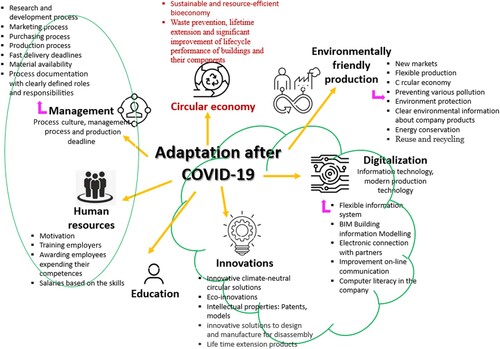
The response to the pandemic has shown that rapid social change is possible; COVID-19 presents a once-in-a-lifetime opportunity to shift the global development paradigm toward greater sustainability and a greener, more inclusive economy, in which forests can play a crucial role (Stanturf and Mansuy Citation2021).
Our results can provide a framework for assessing long-term effects over the next decade. COVID-19 will have a long-term impact and be entangled with other drivers and ongoing trends.
Acknowledgments
Funding: This study was supported by the Slovenian Research Agency, Program P4-0015, P4-0059, and bilateral project BI-US/22-24-043. The authors would like to thank all the survey and interview participants who gave their time to support this study, individuals and organizations who helped distribute the survey and reviewers for their helpful comments.
Disclosure statement
No potential conflict of interest was reported by the author(s).
Additional information
Funding
References
- Agency for Statistics of Bosnia and Herzegovina (BHAS) (2020a) http://www.bhas.ba/?lang=en.
- Barbu, M. C. and Tudor, M. (2021) State of the art of the Chinese forestry, wood industry and its markets. Wood Material Science & Engineering, 1–10. doi:10.1080/17480272.2021.1891457
- Chen, J. and Yang, C.-C. (2021) The impact of the COVID-19 pandemic on consumers’ preferences for wood furniture: An accounting perspective. Forests, 12, 1637. doi:10.3390/f12121637
- Damery, D. T. and Fisette, P. (2001) Decision making in the purchase of siding: a survey of architects, contractors, and homeowners in the US northeast. Forest Product Journal, 51(7/8), 29–36.
- Fan, W. and Yan, Z. (2010) Factors affecting response rates of the web survey: a systematic review. Computers in Human Behavior, 26(2), 132–139. doi:10.1016/j.chb.2009.10.015
- FAO (2020) Global forest resources assessment, https://www.fao.org/documents/card/en/c/ca8753en/.
- FAOSTAT (2020) Forestry Production and Trade (FAOSTAT). www.fao.org/faostat/en/#data/FO.
- FAO, UECE (2021) COVID-19 impacts on the forest sector in countries in the Western Balkans with a focus on Albania, Bosnia and Herzegovina, Montenegro, North Macedonia, and Serbia. 27 p.
- FAO-WISDOM (Woodfuel Integrated Supply /Demand Overview Mapping) (2020) FAO WISDOM projects for Albania; Bosnia and Herzegovina, Montenegro, North Macedonia; and Serbia. http://www.fao.org/home/search/en/?q=WISDOM.
- Financial Agency – FINA (2021) https://www.fina.hr/en/homepage.
- Hightower, M. (2020) COVID-19’s impact on forest products industry could linger into 2021. Arkansas Agricultural Experiment Statton News. https://aaes.uada.edu/news/covid-19s-impact-on-forest-products-industry-could-linger-into-2021/.
- INSTAT-Institute for Statistics of Albania (2020) http://www.instat.gov.al/en/.
- Jelačić, D., Pirc Barčić, A., Oblak, L., Motik, D., Grošelj, P. and Jošt, M. (2021) Sustainable production management model for small and medium enterprises in some south-central EU countries. Sustainability, 13(11), 6220. doi:10.3390/su13116220
- Kitek Kuzman, M., Klarić, S., Pirc Barčić, A., Vlosky, R. P., Janakieska, M. and Grošelj, P. (2018) Architect perceptions of engineered wood products: An exploratory study of selected countries in Central and Southeast Europe. Construction and Building Materials, 179, 360–370. doi:10.1016/j.conbuildmat.2018.05.164
- Kitek Kuzman, M. and Sandberg, D. (2017) Comparison of timber-house technologies andinitiatives supporting use of timber in Slovenia and in Sweden - the state of the art. iForest, 10, 930–938. doi:10.3832/ifor2397-010.
- Kozak, R. A. and Cohen, D. H. (1999) Architects, and structural engineers: An examination of wood design and use in nonresidential construction. Forest Product Journal, 49, 37.
- Lazarević, A., Glavonjić, B., Kalem, M. and Mandić, J. (2022) Impact of the COVID-19 pandemic on the furniture market in Serbia. In: Proceedings of the 15th International Scientific Conference WoodEMA 2022, Trnava, Slovak Republic.
- Liu, K., et al. (2020) COVID-19: challenges and perspectives for the pulp and paper industry WorldWide. Bioresources, 15(3), 4638–4641. doi:10.15376/biores.15.3.4638-4641
- Muhammad, A. (2021) Implications of COVID-19 on Tennessee Exports of Forest Products (Knoxville, TN, USA: UTI Institute of Agriculture. UTIA.TENNESSEE.EDU).
- NIAID -National Institute od Allergy and Infection Diseases (2020) COVID-19, MERS & SARS. https://www.niaid.nih.gov/diseases-conditions/covid-19.
- O'Connor, J., Kozak, R., Gaston, C. and Fell, D. (2004) Wood use in nonresidential buildings: opportunities and barriers. Forest Product Journal, 54(3), 19–28.
- Pelkki, M. and Sherman, G. (2020) Forestry’s economic contribution in the United States, 2016. Forest Products Journal, 70(1), 28–38. doi:10.13073/FPJ-D-19-00037
- Pirc Barčić, A., Kitek Kuzman, M., Vergot, T. and Goršelj, P. (2021) Monitoring consumer purchasing behavior for wood furniture before and during the COVID-19 pandemic. Forests, 12, 873. doi:10.3390/f12070873
- Ratnasingam, J., Khoo, A., Jegathesan, N., Wei, L. C., Abd Latib, H., Thanasegaran, G., … Amir, M. A. (2020) How are small and medium enterprises in Malaysia’s furniture industry coping with COVID-19 pandemic? early evidences from a survey and recommendations for policymakers. BioResources, 15(3), 5951–5964. doi:10.15376/biores.15.3.5951-5964
- Sandberg, D., Kitek Kuzman, M. and Gaff, M. (2018) Engineered Wood Products. Wood as an Engineering and Architectural Material (Prag, CZ: Czech University of Life Science Prague).
- Saxena, A., et al. (2021) Forest livelihoods and a “green recovery” from the COVID-19 pandemic: insights and emerging research priorities from India. Forest Policy and Economics, 131, 102550. doi:10.1016/j.forpol.2021.102550
- Ščap, Š, Kranjc, N. and Stare, D. (2021) Wood Products Statement with the Forecast. Market Barbustatement 2021 (Ljubljana: Slovenian Forestry Institute, Ministry of agriculture, forestry and food). 24.
- Shen, H., et al. (2020) The Impact of the COVID-19 pandemic on firm performance. Emerging Markets Finance and Trade, 56(10), 2213–2230. doi:10.1080/1540496X.2020.1785863
- Smart specialization strategy of the Republic of Slovenia (2014) Government Office for Development and European Cohesion Policy: 91 p.
- Stanturf, J. A. and Mansuy, N. (2021) COVID-19 and forests in Canada and the United States: initial assessment and beyond. Frontiers in Forests and Global Change, 4, 1–16. doi:10.3389/ffgc.2021.666960
- Statistical office of the Republic of Croatia (2021) https://www.dzs.hr.
- Statistical Office of the Republic of Serbia (2020) https://www.stat.gov.rs/en-US/.
- Statistical office of the Republic of Slovenia (SORS) (2021) https://www.stat.si/statweb/en.
- Størdal, S., Lien, G. and Trømborg, E. (2021) Impacts of infectious disease outbreaks on firm performance and risk: The forest industries during the COVID-19 pandemic. Journal of Risk and Financial Management, 14(7), 318. doi:10.3390/jrfm14070318
- Tao, C., Diao, G. and Cheng, B. (2021) The dynamic impacts of the COVID-19 pandemic on Log prices in China: An analysis based on the TVP-VAR model. Forests, 12(4), 449. doi:10.3390/f12040449
- Wagner, E. and Hansen, E. (2004) The dynamic impacts of the COVID-19 pandemic on Log prices in China: An analysis based on the TVP-VAR model. Forests, 12(1), 449–425. doi:10.3390/f12040449




